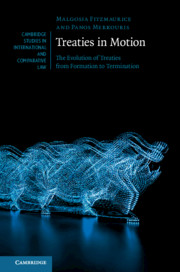Book contents
- Treaties in Motion
- Cambridge Studies in International and Comparative Law: 149
- Treaties in Motion
- Copyright page
- Contents
- Figures
- Tables
- Acknowledgements
- List of Abbreviations
- Table of Cases
- Table of Treaties
- 1 Motion as a Notion
- 2 Treaty Genesis
- 3 Consent to Be Bound
- 4 Treaty Interpretation and Its Rules
- 5 Amendment/Modification/Revision of Treaties
- 6 Treaties and Their Phthora
- 7 Concluding Remarks
- Bibliography
- Index
- Cambridge Studies in International and Comparative Law
6 - Treaties and Their Phthora
Withdrawing from and Terminating/Suspending Treaties
Published online by Cambridge University Press: 05 June 2020
- Treaties in Motion
- Cambridge Studies in International and Comparative Law: 149
- Treaties in Motion
- Copyright page
- Contents
- Figures
- Tables
- Acknowledgements
- List of Abbreviations
- Table of Cases
- Table of Treaties
- 1 Motion as a Notion
- 2 Treaty Genesis
- 3 Consent to Be Bound
- 4 Treaty Interpretation and Its Rules
- 5 Amendment/Modification/Revision of Treaties
- 6 Treaties and Their Phthora
- 7 Concluding Remarks
- Bibliography
- Index
- Cambridge Studies in International and Comparative Law
Summary
Chapter 6 deals with the final motion relating to a treaty, ie its destruction (phthora). To this effect, the chapter starts with an examination of withdrawal from a treaty, even when no such withdrawal clause exists, and the possibility of revocation of a notification of withdrawal. This last one rose to prominence with Brexit and the Wightman cases. The situation is further complicated by the fact that anomalous situations can also occur where termination or suspension may be required. Chapter 6 does not examine only the existing grounds of termination/suspension under the VCLT, but also certain grounds that despite not being included in the VCLT have been argued to provide additional, customary law-based grounds for termination/suspension. Two kinds of motion are examined in this context: i) the motion between the VCLT and non-VCLT alleged grounds for termination/suspension, ie the connections, near identity and in some cases suggested absorption of one ground by another; and ii) the motion between, on the one hand, the grounds for termination/suspension, as a subset of treaty law, and, on the other hand, other sets of rules such as State responsibility.
Keywords
- Type
- Chapter
- Information
- Treaties in MotionThe Evolution of Treaties from Formation to Termination, pp. 270 - 333Publisher: Cambridge University PressPrint publication year: 2020

